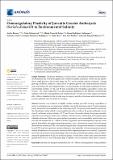Por favor, use este identificador para citar o enlazar a este item:
http://hdl.handle.net/10261/268154COMPARTIR / EXPORTAR:
 SHARE SHARE
 CORE
BASE CORE
BASE
|
|
| Visualizar otros formatos: MARC | Dublin Core | RDF | ORE | MODS | METS | DIDL | DATACITE | |

| Título: | Osmoregulatory plasticity of juvenile greater amberjack (Seriola dumerili) to environmental salinity |
Autor: | Barany, Andre; Gilannejad, Neda CSIC ORCID ; Alameda-López, María; Rodríguez-Velásquez,Liliana; Astola, A. CSIC ORCID; Martínez-Rodríguez, Gonzalo CSIC ORCID ; Roo, Javier; Muñoz, José Luis; Mancera, Juan Miguel | Palabras clave: | Intestine Ion transport Metabolism Na+/K+-ATPase Osmoregulation Ussing chambers |
Fecha de publicación: | 5-sep-2021 | Editor: | Molecular Diversity Preservation International | Citación: | Animals 11(9): 2607 (2021) | Resumen: | Osmotic costs in teleosts are highly variable, reaching up to 50% of energy expenditure in some. In several species, environmental salinities close to the isosmotic point (~15 psu) minimize energy demand for osmoregulation while enhancing growth. The present study aimed to characterize the physiological status related to osmoregulation in early juveniles of the greater amberjack, Seriola dumerili, acclimated to three salinities (15, 22, and 36 psu). Our results indicate that plasma metabolic substrates were enhanced at the lower salinities, whereas hepatic carbohydrate and energetic lipid substrates decreased. Moreover, osmoregulatory parameters, such as osmolality, muscle water content, gill and intestine Na-K-ATPase activities, suggested a great osmoregulatory capacity in this species. Remarkably, electrophysiological parameters, such as short-circuit current (Isc) and transepithelial electric resistance (TER), were enhanced significantly at the posterior intestine. Concomitantly, Isc and TER anterior-to-posterior intestine differences were intensified with increasing environmental salinity. Furthermore, the expression of several adeno-hypophyseal genes was assessed. Expression of prl showed an inverse linear relationship with increasing environmental salinity, while gh mRNA enhanced significantly in the 22 psu-acclimated groups. Overall, these results could explain the better growth observed in S. dumerili juveniles kept at salinities close to isosmotic rather than in seawater. | Versión del editor: | http://dx.doi.org/10.3390/ani11092607 | URI: | http://hdl.handle.net/10261/268154 | DOI: | 10.3390/ani11092607 | Identificadores: | doi: 10.3390/ani11092607 e-issn: 2076-2615 |
| Aparece en las colecciones: | (ICMAN) Artículos |
Ficheros en este ítem:
| Fichero | Descripción | Tamaño | Formato | |
|---|---|---|---|---|
| animals-11-02607.pdf | 1,26 MB | Adobe PDF |  Visualizar/Abrir |
CORE Recommender
Page view(s)
49
checked on 23-abr-2024
Download(s)
33
checked on 23-abr-2024
Google ScholarTM
Check
Altmetric
Altmetric
Este item está licenciado bajo una Licencia Creative Commons

